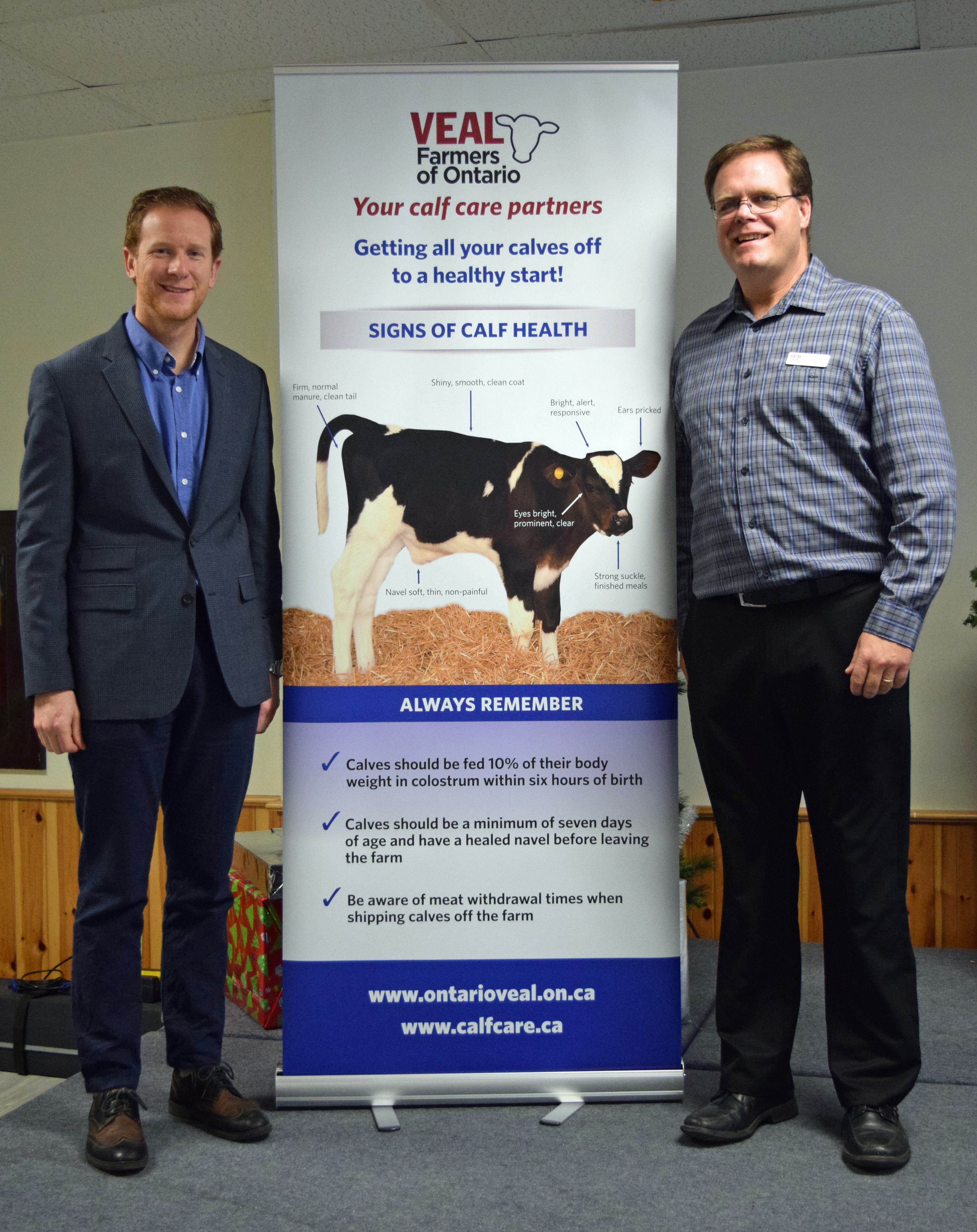Standardized and timely calf health assessments can have a positive impact on the animal’s long-term productivity.

Dr Dave Renaud & VFO Chair, Brian Keunen
To be most effective, they must be done at the right time and always done the same way, stated Dr. Dave Renaud, with the Department of Population Medicine, at the University of Guelph. He made the comment at the recent Building the Foundation 2016 Dairy and Veal Healthy Calf Conference. The event was hosted by Veal Farmers of Ontario (VFO) with support through Growing Forward 2, a federal-provincial-territorial initiative.
A key time to assess calf health is at calving, which will be one of the most traumatic events in the animal’s life. Abnormal or difficult births, called dystocia, can have both short-term and long-term impacts, from high pre-birth and pre-weaning mortality and lower passive immunity to lower milk production later in life.
“Dystocia has many impacts like bleeding, broken ribs, impaired breathing, and an impaired ability to thermoregulate,” explained Renaud, adding that research has found a 703 kilogram reduction in 305-day milk yield in animals born with veterinary assistance compared to those born independently.
When assessing calf health at birth, a vigour scoring chart can be a helpful tool. Look for key indicators, advised Renaud, such as:
- Visual appearance of the tongue and head – is either swollen?
- Responsiveness to straw in the nasal cavity – does it move its head when poked?
- Heart and respiratory rate
- Ability to perform tasks at birth – how long until the calf holds its head up, attempts to stand, stands? How strong is its’ suckle reflex?
Calves with poor vigour are susceptible to cold stress, Renaud advised, so it’s important to warm them with a heat lamp, straw or a calf jacket. Use a Non-Steroidal Anti-Inflammatory Drug (NSAID) like meloxicam to improve vigour and suckle reflex as well as boost pre-weaning weight gain and health.
“Feed colostrum as soon as possible even if they won’t suckle; use a tube feeder if needed,” Renaud explained. “This is important especially in calves with dystocia.”
It’s important to check the animal twice daily for signs of disease, especially at critical periods such as pre-weaning and when colostral immunity is declining after 14 to 21 days. Early detection of problems such as diarrhea and pneumonia can prevent adverse short-term and long-term impacts in the calf.
According to Renaud, diarrhea is the leading cause of mortality in calves less than 30 days of age and accounts for 7.5 per cent of all mortalities in milk-fed veal. Long-term, a calf’s growth rate is reduced by 18 per cent if it suffers from diarrhea during its first 60 days of life – ultimately resulting in increased age at first calving in heifers.
The economic cost of diarrhea is significant at $33.46 per pre-weaned calf per year, research has found.
Pneumonia is the highest cause of death in Holstein dairy calves over 30 days of age and the highest cause of death in milk-fed veal. Long-term growth impacts of the disease include increased age at first calving and a higher risk of dystocia at first calving, and a cost of $25 to $81 per case.
The third most common cause of calf mortality is navel infection, caused by bacterial invasion through the umbilical cord. In severe cases it can result in septicemia, leading to organ failure, meningitis and severe arthritis, but growth impacts are most common. Research has found a nine kg reduction in growth if a calf suffers a navel infection in its first three months of life.
“The take-home is that all three of these diseases have short- and long-term impacts and costs involving treatment and labour,” said Renaud. “If you can detect them early, you can prevent long-term impact and reduce mortality and morbidity.”
So how to assess calf health?
It requires training and experience, and the challenge is that changes in calf health can often be very subtle like drinking more slowly or standing at the back of a pen, so working with a veterinarian is important, Renaud recommended.
A health-scoring app developed by the University of Wisconsin lets users enter scores for respiratory and digestive systems and navel ill for each calf. The app recommends actions including treatment, rechecking or no follow up needed.
For pneumonia, calf health-scoring criteria includes: eyes, ears and nose. With navel ill, palpate the navel, and look at temperature and attitude. When it comes to diarrhea, it’s dehydration that kills the calf and the more water they lose, the more depressed their state so restoring their water balance is crucial.
“If you combine all three – pneumonia, diarrhea and navel infection – and keep this in the back of your mind, you can create a systemic and standardized approach to looking at calves,” Renaud said. “You can identify calves sooner that need treatment. “
